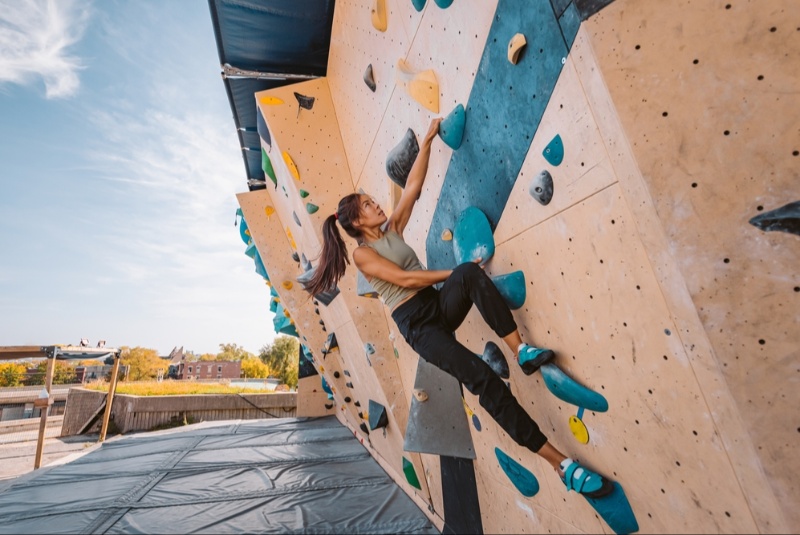Rock climbing is more than a sport—it's a holistic engagement that chisels the body and forges the spirit. To master the vertical chessboard of crags and crevices, climbers must develop a triad of physical robustness and psychological resilience: strength, endurance, and mental toughness. In this comprehensive foray into the world of rock climbing, we'll delve into how climbers build these core attributes and why they are indispensable for scaling the lofty battlements of Earth's natural fortresses.
The Bedrock of Ascension: Building Strength in Rock Climbing
Rock climbing is an arduous activity that demands substantial upper and lower body strength. Each movement is a concert of muscles flexing and releasing, from the powerful grip of fingers around a tiny hold to the forceful push of the legs. Climbers build strength primarily through climbing itself, but supplementary exercises can significantly hasten this process.
Targeted Training for Climbers
To cultivate climbing-specific strength, one must engage in a variety of exercises that mimic climbing movements or stimulate climbing muscles. Here are some of the cornerstone workouts:
- Pull-ups and Hangboard Workouts: These enhance arm, shoulder, and finger strength—vital for holding onto grips and sustaining body weight during a climb.
- Deadlifts and Squats: By targeting the core and legs, these compound movements lay a foundation for explosive leg power and solid body tension while on the wall.
- Core Workouts: A climber's core is their center of gravity and stability. Planks, leg raises, and twisted sit-ups keep climbers from 'barn-dooring' (swinging out from the wall) on challenging routes.
- Campus Board Training: Advanced climbers use campus boards to build power. The rung-to-rung dynamic movement hones explosive strength and contact strength (the ability to quickly generate grip force).
Functional Fitness
Strength in rock climbing isn't just about muscle; it's about how those muscles work in concert during complex movements. Exercises that promote functional fitness, such as yoga or pilates, can enhance balance and body awareness—two critical aspects of climbing strength.
Endurance: The Sustaining Force of a Climber
While strength gets a climber up a few holds, endurance allows them to summit entire routes. Endurance in climbing is two-fold: muscular endurance, the ability to sustain climbing movements, and aerobic endurance, the ability to recover quickly between bursts of effort.
Strategies to Build Climbing Endurance
- Long, Easy Climbs: By regularly engaging in climbs that are below their maximum difficulty, climbers improve their aerobic capacity and muscle endurance without overstraining.
- Interval Training: Alternating between high-intensity climbing and rest periods can increase aerobic and anaerobic endurance.
- 4x4 Drills: Performing four boulder problems back-to-back, four times, with short rest intervals in between, pushes the anaerobic system and builds power endurance.
Rest and Recovery
Climbers should not underestimate the power of rest in building endurance. Proper recovery, including adequate sleep and nutrition, allows muscles to repair and grow stronger, thereby increasing a climber's staying power on the wall.
The Summit in Sight: Cultivating Mental Toughness in Climbing
Beyond physical capabilities, mental toughness is a critical component of a successful climb. Climbing is as much about outthinking the rock as it is about outperforming it.
Mental Training for Climbers
- Visualization: Before attempting a climb, many climbers visualize each move. This mental rehearsal prepares the mind for the task ahead and can improve focus and reduce anxiety.
- Breathing Techniques: Controlled breathing not only regulates heart rate but also maintains calmness during stressful situations on the rock.
- Goal Setting: Setting short-term, achievable goals can keep motivation high and provide a psychological edge.

Overcoming Fear
Fear of falling or failing can be paralyzing in climbing. To build mental toughness, climbers practice falls in a controlled environment to become accustomed to the sensation and to trust their gear. Additionally, learning to fail gracefully—recognizing that failure is an essential step towards improvement—can transform one's mental approach to challenges.
Incorporating Mindfulness
Rock climbing requires acute presence of mind. Practicing mindfulness can sharpen a climber's focus, allowing for better problem-solving and movement efficiency on the rock. Mindfulness also enhances the enjoyment of the climb, helping climbers to be fully engaged in the experience.
Nutrition and Hydration: The Unsung Heroes of Climbing Fitness
A well-nourished body performs better, and climbers are no exception. A diet rich in proteins for muscle repair, carbohydrates for energy, and fats for sustained fuel is vital. Hydration, too, plays a critical role in performance—dehydration can quickly sap a climber's strength and endurance.
The Integration of Strength, Endurance, and Mental Toughness
In rock climbing, these three attributes are deeply interconnected. Strength without endurance is like a flash of lightning without the rolling thunder—a brilliant display that fades too quickly. Endurance without strength is a river without a bed, lacking the power to carve landscapes. And physical attributes without mental toughness are like a rudderless ship, strong and capable yet directionless.
Climbers who integrate these aspects are the ones who push boundaries, redefine possible, and stand atop podiums, both literal and metaphorical. But the beauty of climbing is that it's not just about the summit; it's about the ascent—the journey that carves out stronger, more enduring, and mentally resilient individuals.
Rock climbing is a multifaceted discipline that compels its practitioners to build comprehensive strength, sustained endurance, and ironclad mental toughness. It's an amalgam of art and athletics, a dance between gravity and willpower. For those who choose to undertake this vertical pilgrimage, the rewards transcend physical gains. Climbing imprints lessons of perseverance, teaches the value of incremental progress, and provides a humbling yet exhilarating perspective that few other sports can offer.
From the granitic spires of Yosemite to the sandstone arches of the desert Southwest, climbing beckons with the promise of adventure and self-discovery. It's a pursuit that demands much but gives back exponentially—in fitness, in fortitude, and in the unyielding joy of ascending towards the sky, one hold at a time.




